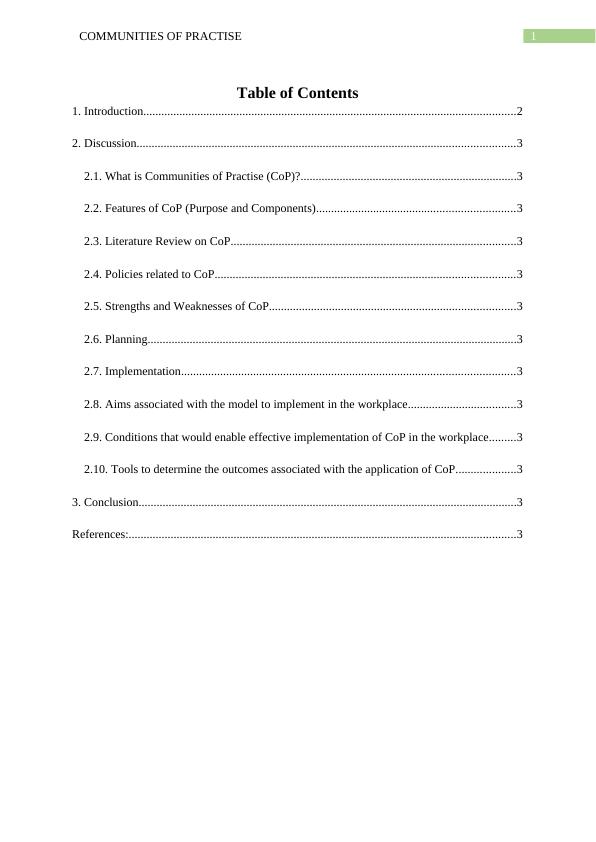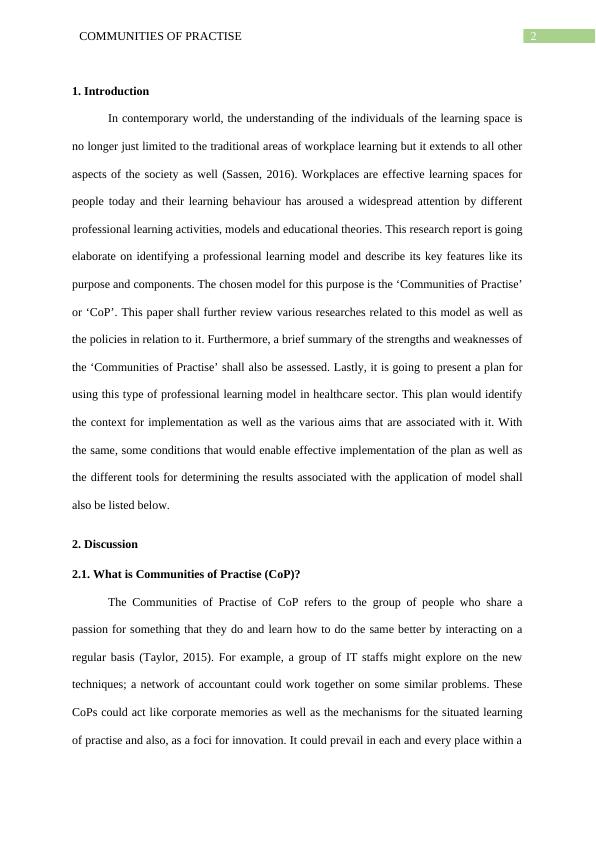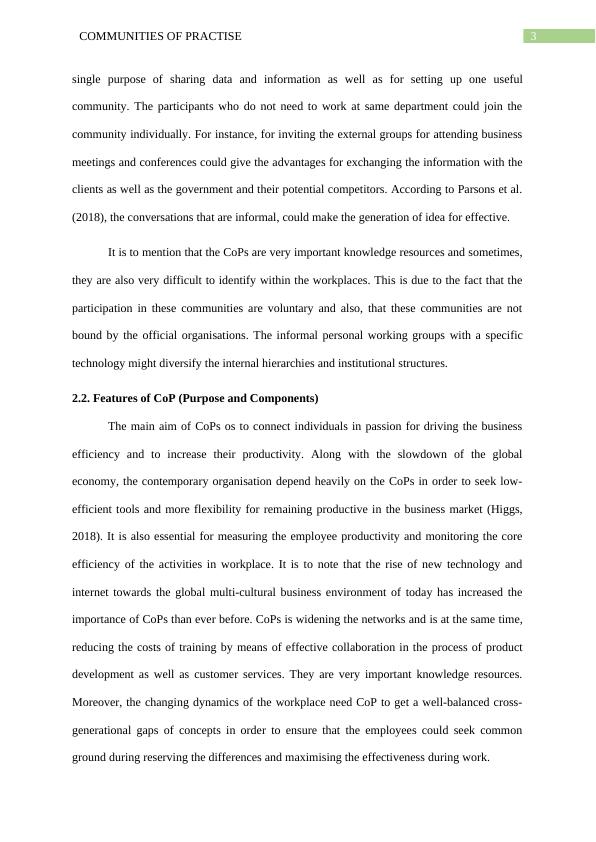Communities of Practise
Added on 2023-04-23
12 Pages3538 Words302 Views
Running head: COMMUNITIES OF PRACTISE
Communities of Practise
Name of the Student:
Name of the University:
Author note:
Communities of Practise
Name of the Student:
Name of the University:
Author note:

1COMMUNITIES OF PRACTISE
Table of Contents
1. Introduction............................................................................................................................2
2. Discussion..............................................................................................................................3
2.1. What is Communities of Practise (CoP)?........................................................................3
2.2. Features of CoP (Purpose and Components)..................................................................3
2.3. Literature Review on CoP...............................................................................................3
2.4. Policies related to CoP....................................................................................................3
2.5. Strengths and Weaknesses of CoP..................................................................................3
2.6. Planning...........................................................................................................................3
2.7. Implementation...............................................................................................................3
2.8. Aims associated with the model to implement in the workplace....................................3
2.9. Conditions that would enable effective implementation of CoP in the workplace.........3
2.10. Tools to determine the outcomes associated with the application of CoP....................3
3. Conclusion..............................................................................................................................3
References:.................................................................................................................................3
Table of Contents
1. Introduction............................................................................................................................2
2. Discussion..............................................................................................................................3
2.1. What is Communities of Practise (CoP)?........................................................................3
2.2. Features of CoP (Purpose and Components)..................................................................3
2.3. Literature Review on CoP...............................................................................................3
2.4. Policies related to CoP....................................................................................................3
2.5. Strengths and Weaknesses of CoP..................................................................................3
2.6. Planning...........................................................................................................................3
2.7. Implementation...............................................................................................................3
2.8. Aims associated with the model to implement in the workplace....................................3
2.9. Conditions that would enable effective implementation of CoP in the workplace.........3
2.10. Tools to determine the outcomes associated with the application of CoP....................3
3. Conclusion..............................................................................................................................3
References:.................................................................................................................................3

2COMMUNITIES OF PRACTISE
1. Introduction
In contemporary world, the understanding of the individuals of the learning space is
no longer just limited to the traditional areas of workplace learning but it extends to all other
aspects of the society as well (Sassen, 2016). Workplaces are effective learning spaces for
people today and their learning behaviour has aroused a widespread attention by different
professional learning activities, models and educational theories. This research report is going
elaborate on identifying a professional learning model and describe its key features like its
purpose and components. The chosen model for this purpose is the ‘Communities of Practise’
or ‘CoP’. This paper shall further review various researches related to this model as well as
the policies in relation to it. Furthermore, a brief summary of the strengths and weaknesses of
the ‘Communities of Practise’ shall also be assessed. Lastly, it is going to present a plan for
using this type of professional learning model in healthcare sector. This plan would identify
the context for implementation as well as the various aims that are associated with it. With
the same, some conditions that would enable effective implementation of the plan as well as
the different tools for determining the results associated with the application of model shall
also be listed below.
2. Discussion
2.1. What is Communities of Practise (CoP)?
The Communities of Practise of CoP refers to the group of people who share a
passion for something that they do and learn how to do the same better by interacting on a
regular basis (Taylor, 2015). For example, a group of IT staffs might explore on the new
techniques; a network of accountant could work together on some similar problems. These
CoPs could act like corporate memories as well as the mechanisms for the situated learning
of practise and also, as a foci for innovation. It could prevail in each and every place within a
1. Introduction
In contemporary world, the understanding of the individuals of the learning space is
no longer just limited to the traditional areas of workplace learning but it extends to all other
aspects of the society as well (Sassen, 2016). Workplaces are effective learning spaces for
people today and their learning behaviour has aroused a widespread attention by different
professional learning activities, models and educational theories. This research report is going
elaborate on identifying a professional learning model and describe its key features like its
purpose and components. The chosen model for this purpose is the ‘Communities of Practise’
or ‘CoP’. This paper shall further review various researches related to this model as well as
the policies in relation to it. Furthermore, a brief summary of the strengths and weaknesses of
the ‘Communities of Practise’ shall also be assessed. Lastly, it is going to present a plan for
using this type of professional learning model in healthcare sector. This plan would identify
the context for implementation as well as the various aims that are associated with it. With
the same, some conditions that would enable effective implementation of the plan as well as
the different tools for determining the results associated with the application of model shall
also be listed below.
2. Discussion
2.1. What is Communities of Practise (CoP)?
The Communities of Practise of CoP refers to the group of people who share a
passion for something that they do and learn how to do the same better by interacting on a
regular basis (Taylor, 2015). For example, a group of IT staffs might explore on the new
techniques; a network of accountant could work together on some similar problems. These
CoPs could act like corporate memories as well as the mechanisms for the situated learning
of practise and also, as a foci for innovation. It could prevail in each and every place within a

3COMMUNITIES OF PRACTISE
single purpose of sharing data and information as well as for setting up one useful
community. The participants who do not need to work at same department could join the
community individually. For instance, for inviting the external groups for attending business
meetings and conferences could give the advantages for exchanging the information with the
clients as well as the government and their potential competitors. According to Parsons et al.
(2018), the conversations that are informal, could make the generation of idea for effective.
It is to mention that the CoPs are very important knowledge resources and sometimes,
they are also very difficult to identify within the workplaces. This is due to the fact that the
participation in these communities are voluntary and also, that these communities are not
bound by the official organisations. The informal personal working groups with a specific
technology might diversify the internal hierarchies and institutional structures.
2.2. Features of CoP (Purpose and Components)
The main aim of CoPs os to connect individuals in passion for driving the business
efficiency and to increase their productivity. Along with the slowdown of the global
economy, the contemporary organisation depend heavily on the CoPs in order to seek low-
efficient tools and more flexibility for remaining productive in the business market (Higgs,
2018). It is also essential for measuring the employee productivity and monitoring the core
efficiency of the activities in workplace. It is to note that the rise of new technology and
internet towards the global multi-cultural business environment of today has increased the
importance of CoPs than ever before. CoPs is widening the networks and is at the same time,
reducing the costs of training by means of effective collaboration in the process of product
development as well as customer services. They are very important knowledge resources.
Moreover, the changing dynamics of the workplace need CoP to get a well-balanced cross-
generational gaps of concepts in order to ensure that the employees could seek common
ground during reserving the differences and maximising the effectiveness during work.
single purpose of sharing data and information as well as for setting up one useful
community. The participants who do not need to work at same department could join the
community individually. For instance, for inviting the external groups for attending business
meetings and conferences could give the advantages for exchanging the information with the
clients as well as the government and their potential competitors. According to Parsons et al.
(2018), the conversations that are informal, could make the generation of idea for effective.
It is to mention that the CoPs are very important knowledge resources and sometimes,
they are also very difficult to identify within the workplaces. This is due to the fact that the
participation in these communities are voluntary and also, that these communities are not
bound by the official organisations. The informal personal working groups with a specific
technology might diversify the internal hierarchies and institutional structures.
2.2. Features of CoP (Purpose and Components)
The main aim of CoPs os to connect individuals in passion for driving the business
efficiency and to increase their productivity. Along with the slowdown of the global
economy, the contemporary organisation depend heavily on the CoPs in order to seek low-
efficient tools and more flexibility for remaining productive in the business market (Higgs,
2018). It is also essential for measuring the employee productivity and monitoring the core
efficiency of the activities in workplace. It is to note that the rise of new technology and
internet towards the global multi-cultural business environment of today has increased the
importance of CoPs than ever before. CoPs is widening the networks and is at the same time,
reducing the costs of training by means of effective collaboration in the process of product
development as well as customer services. They are very important knowledge resources.
Moreover, the changing dynamics of the workplace need CoP to get a well-balanced cross-
generational gaps of concepts in order to ensure that the employees could seek common
ground during reserving the differences and maximising the effectiveness during work.

End of preview
Want to access all the pages? Upload your documents or become a member.
Related Documents
Technology at Worklg...
|14
|3585
|124
Self-Development as a Leader: Reflection on Personal Leadership Development Strategylg...
|10
|2476
|99
Written Reflectionlg...
|5
|885
|466
Understanding the Principles and Practices of Assessmentlg...
|7
|1463
|192
Personal Leadership Development Planlg...
|13
|3815
|197
Report on Continuing Professional Development (CPD)lg...
|18
|4022
|29